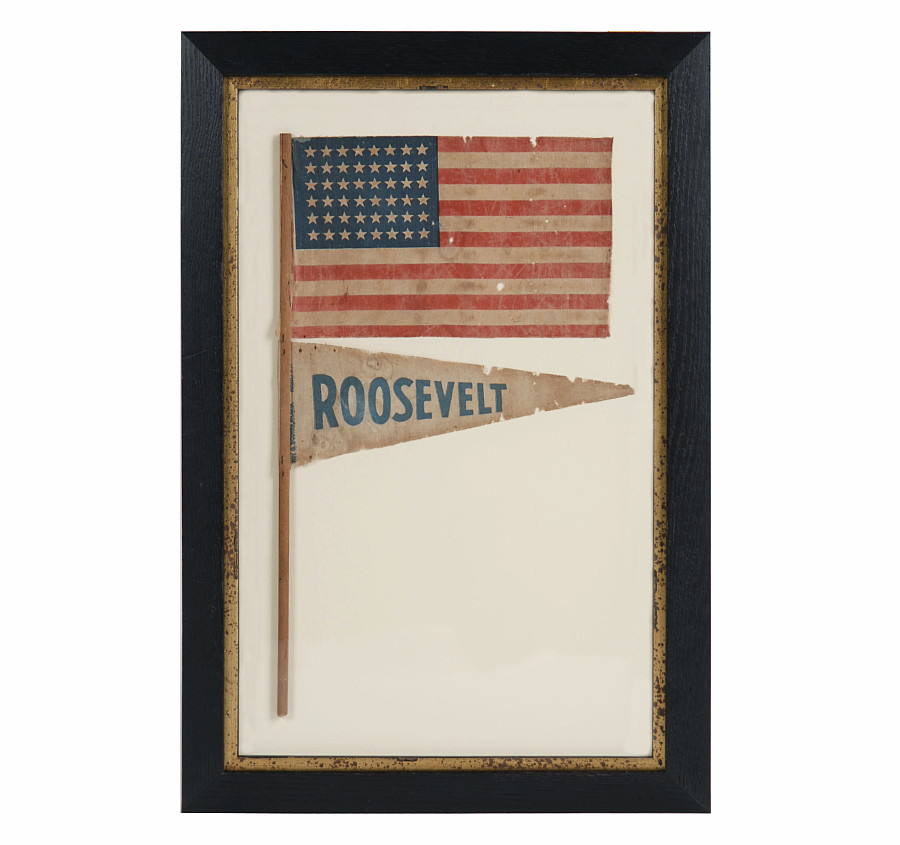
| |
48 STAR PARADE FLAG AND PENNANT COMBINATION ON THE ORIGINAL WOODEN STAFF, MADE FOR ONE OF THE PRESIDENTIAL CAMPAIGNS OF FRANKLIN DELANO ROOSEVELT (1932, 36, 40, OR 44) |
|
| Available: |
Sold |
| Frame Size (H x L): |
22.75" x 15.25" |
| Flag Size (H x L): |
Flag: 6"x 9.25" on 17" staff Pennant 3.5" x 10" |
|
| Description....: |
|
48 STAR PARADE FLAG AND PENNANT COMBINATION ON THE ORIGINAL WOODEN STAFF, MADE FOR ONE OF THE PRESIDENTIAL CAMPAIGNS OF FRANKLIN DELANO ROOSEVELT (1932, 36, 40, OR 44):
48 star American National parade flag, printed on cotton and affixed to its original staff. The flag is accompanied on the staff by a small white pennant, positioned below it, on which the word "Roosevelt" is printed in blue. This was to support one of the four times that Franklin Delano Roosevelt campaigned for and obtained the Nation's highest office (1932, 36, 40, and 44).
While this is an undocumented example, I have seen two other copies of it in this exact style. The fact that this is a split staff, with the split tailored to the according size so that the flag and pennant could be sandwiched inside and nailed into place, is evidence that they were intended by the maker to be displayed in this fashion.
Because the flag and pennant combination is undocumented, the date of its manufacture is unclear. Whatever the case may be, this great little FDR campaign piece is a nice representation of the departure from the practice of printing names and faces of political candidates directly onto the Stars & Stripes. The flag ethics that we have today began to emerge around 1890. It was at this time that public moved toward treatment of the flag as a sacred object. Twice during that decade bills were brought before Congress that attempted to outlaw the use of national symbols for the purposes of advertising, and although such legislation didn't pass into law until 1905, a keen absence of post-1890 examples with lettering or images printed directly on them is evidence of the fact that politicians shied away from advertising on the flag. In fact, very few identifiable campaign flags of any type exist from the 20th century, which makes this style particularly interesting, no matter if the advertising appears directly on it or not.
It is interesting to note that Roosevelt's election to his fourth presidential term in 1944 led to the passing of the 22nd Amendment to the U.S. Constitution, which imposed a two-term limit.
Mounting: The frame consists of a late 19th century, American, solid oak molding with a beveled profile that has been married to a modern, hand-gilded and distressed Italian liner. The flag has been hand-stitched to 100% rag mat. Spacers keep the textile away from the glass, which is U.V. protective. |
|
|
|
| Collector Level: |
Intermediate-Level Collectors and Special Gifts |
|
| Flag Type: |
Parade flag |
|
| Star Count: |
48 |
|
| Earliest Date of Origin: |
1932 |
|
| Latest Date of Origin: |
1944 |
|
| State/Affiliation: |
New York |
|
| War Association: |
WW 2 |
|
| Price: |
SOLD |
|
| |
Views: 2704 |
|
|
|

